QA October 27, 2022
Our office has been closed this week, so I do not have questions as usual for you this time around. If you submitted a question via last week’s e-gardens, I’ll have your reply in the November 3 edition.
For this week…
Having been at the Q&A game for 53 years here in Texas, I have a good idea of what gardeners are wanting to know at this time of year. Here are a few of the most-asked questions of late fall along with my answers to them. I hope they’re of help to you.
QUESTION 1
WHAT DO I DO WITH MUMS WHEN THEY’RE FINISHED BLOOMING?
Question: Now that my mums are starting to turn brown, what should I do with them over the winter?

Answer: Look down near the ground and you’ll see small shoots starting to emerge from the base of each flowering stalk. Those will be next year’s stems, and you can remove everything down to them. Once they’re no longer attractive, trim off the spent flower heads and all their stems. Do not trim any of the new clumps that have started to emerge. Leave perhaps 1 or 2 inches of each stalk to serve as markers over the winter.
And that’s it. The new clumps will sit there all winter before they spring out with new growth in March. If you intend to dig and divide your mums, you can either do so immediately after you trim off the dead stems, or you can wait until just before the new growth commences in late winter.
QUESTION 2
WHY DO WE GET BETTER FALL COLOR SOME YEARS THAN OTHERS?
Question: Why do shade trees vary in the intensity of their fall color from one year to the next?

Answer: Our state isn’t known for blazing fall foliage, but we do get a reasonable share in most years. In general terms here are factors that contribute to giving us the very best fall color in Texas.
• Tree species. You’ll almost always get great color out of Chinese pistachios (reds, burgundy, yellows and oranges), pears (reds, burgundy, yellows and oranges), ginkgoes (golden yellow) and, where they’re adapted (primarily in East Texas), sweet gums (reds, burgundy, yellows and oranges). You’ll never get good fall color out of bur oaks or pecans. In between, you’ll often get good color from crape myrtles and red oaks.
• Exposure to cold. Red and yellow pigments don’t show up unless you have gradually lowering temperatures. Warm falls don’t promote good fall color.
• Average or below-average moisture. Wet falls promote continued new growth. That comes at the expense of fall color.
• Nitrogen. If your shade trees are in turf areas where you’re applying high-nitrogen fertilizers in September and into October, again the trees may stay vegetative too long.
• And then he said with a wink, there are just some years that are better than others.
QUESTION 3
IS IT A GOOD IDEA TO RAISE THE MOWER HEIGHT GOING INTO THE WINTER?
Question: Should I raise my mowing height going into the winter? What’s the best mowing height for my lawn?”
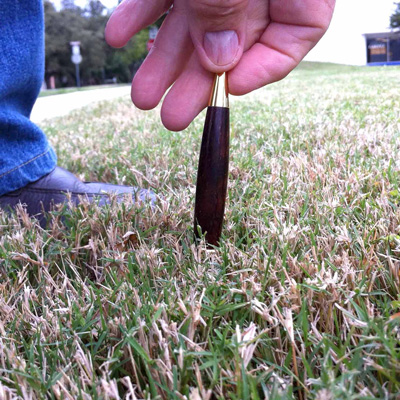
Answer: Raising the mower’s height is rarely a good idea. Here’s why in the late fall and on through the winter:
You gain absolutely no winter protection by mowing your lawn higher when it’s cold. The grass blades shrivel and dry up after they freeze, so any blanket of insulation they might provide is greatly compromised in the process.
Continue to mow at the recommended height, just as you should be doing 12 months out of the year.
Note: It’s not the proper time to be talking about it but raising the mower does not help with summer hardiness either.
Best mowing heights…
• Common bermudagrass: 1-1/4 to 1-1/2 inches.
• Hybrid bermudagrass: depends on the variety being grown. May be as low as 1/4-inch or as high as 3/4-inch. Use a reel mower.
• St. Augustine: 2 to 2-1/2 inches.
• Zoysias: 2 to 3 inches, depending on variety.
• Fescues: 3 to 4 inches, depending on whether it’s a dwarf, turf-type fescue or a taller standard selection.
• Buffalograss: 4 inches.
Note: If you are currently mowing higher than these recommended heights, wait until late winter to adjust your mower settings downward. Scalping is best done in early to mid-February in South Texas, late February farther north.
QUESTION 4
SHOULD HIBISCUS AND BOUGAINVILLEAS BE TRIMMED BEFORE BRINGING THEM INTO THE GARAGE?
Question: Should I trim my bougainvillea and hibiscus plants back before I put them into the garage for the winter?
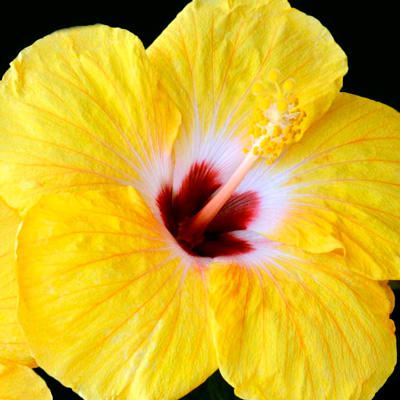
Answer: Yes. Reshape them into more manageable form before you try to bring them inside.
But a big, loud “NO!” for the garage. Garages are usually too dark and too cold for tropicals to survive. If you’re able to put the plants on plant dollies and move them in and out on warm days, that would help. Otherwise, a sunroom or greenhouse would be highly preferable. Or, as many of us do, treat them as annuals and replace them next year.
QUESTION 5
WHAT IS THE BEST QUICK SCREENING SHRUB?
Question: What are the best options for a quick screening plant? We need some privacy for an unsightly view that has cropped up.
Answer: Most people are looking for shrubs that will grow to be 8 to 18 feet tall when they ask that specific question. (Often it’s to replace redtip photinias that have died from incurable Entomosporium fungal leaf spot.) I do suggest, however, that you not decide solely on speed of growth. Fast-growing shrubs all have problems in knowing when to stop growing. They’re all high-maintenance plants that will require frequent pruning to keep them attractive. Many have other serious insect and disease problems as well.
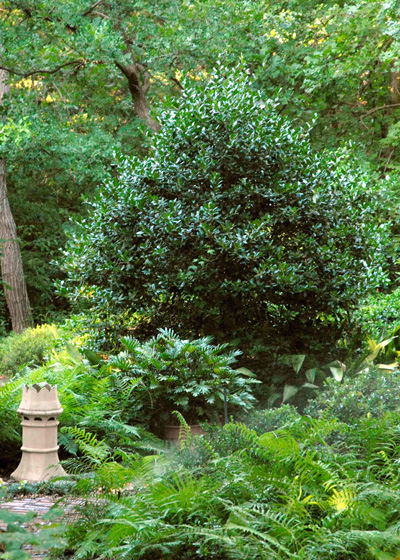
• Nellie R. Stevens hollies grow to 15 to 18 feet tall in sun or shade. They’re available from retail nurseries in all sizes, so you can buy larger plants if you’re in need of the privacy faster. Space them 8 or 10 feet apart. This is a handsome large holly that’s adapted to almost any soil as long as it’s not shallow and rocky. It produces masses of large red berries that hold all through the winter.
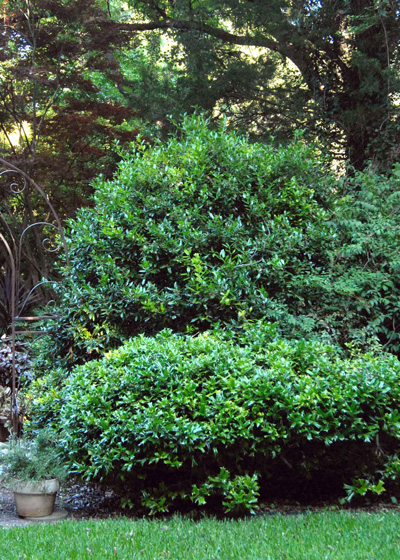
• Willowleaf holly (also known as Needlepoint holly) grows to 10 or 12 feet tall and 8 or 10 feet wide, also in sun or shade. It, too, produces lovely red fruit on deep green, evergreen shrubs. Space them 7 or 8 feet apart.
In the off chance that you need something taller, eastern redcedars spaced at varying distances of 18-22 feet or Little Gem or D.D. Blanchard southern magnolias would be lovely evergreen trees.
QUESTION 6
WOULD IT PROTECT TURF TO LEAVE FALLEN LEAVES ON THE LAWN IN WINTER?
Question: Would it protect my grass from winter’s cold if I were to leave tree leaves in place over it?
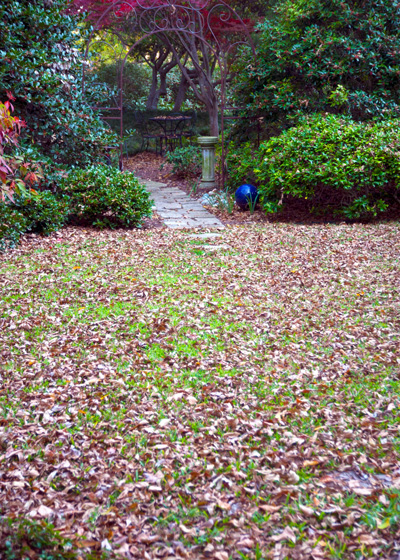
Answer: It is not a good idea. Here are my two main reasons.
1. Not only is warmth trapped beneath the layer of leaves, but so is moisture. The surface is sheltered from the movement of air across the grass, so it doesn’t dry out. And most of us learned a long time ago (perhaps through wet laundry in the hamper) that warmth plus moisture equals mildew and mold. Grass that is covered with leaves is far more likely to come down with diseases.
2. Leaves have a habit of moving around. When the winter wind blasts through, it’s likely to blow the leaves off the grass suddenly exposing it to cold temperatures. St. Augustine is especially vulnerable. It’s sensitive to freeze damage in the northern parts of its range anyway, and when we see its protection becoming airborne, we’re just asking for trouble.
And other factors…
• Leaves are unsightly, so the neighbors probably aren’t going to appreciate your leaving them to blow down the street.
• In extreme situations, those leaves can even become fire hazards as they pile up against fences and structures.
• Eventually you’re going to have to mow and mulch or bag the leaves anyway, so you might as well do it now and put them to use in your landscape beds or in the compost. They’re a natural resource worth saving.
QUESTION 7
WHAT IS THE BEST TIME TO TRANSPLANT SEVERAL TREES IN MY LANDSCAPE?
Question: We are going to be adding a room to our house. We have several trees that I’d like to save. When should they be moved to have the best possible chance of success?
Answer: Wait until they are completely dormant. That will be following the first hard freeze. For most of Texas that means that you can plan on doing the digging during January.
Be careful to hold a firm soil ball around the root systems as you move them. Thin them to compensate for roots lost in the process. Set them at the same depth at which they had been growing before, and stake and guy them to keep them protected from trunk damage and perfectly plumb.
